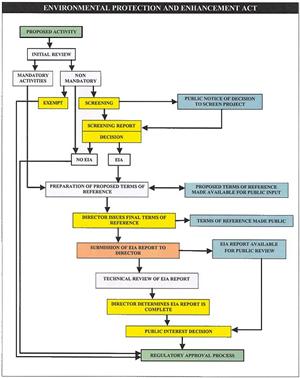The Provincial Process
In Alberta, Environmental Impact Assessments (EIA) are recognized under the Environmental Protection and Enhancement Act (EPEA) under Part 2, Division 1 and mentioned in the Water Act (Alberta Environment 2004). The Alberta Environmental Assessment (AEA) process has been in place since 1973, and was governed by a set of guidelines before being incorporated in the EPEA in 1990.
If the project requires both a federal and provincial assessment the Canada-Alberta Agreement for Environmental Assessment and Cooperation should be consulted. This Agreement was established to minimize duplication and to increase the efficiency of the assessment process. For a discussion on when an assessment under Canadian Environmental Assessment Act would be required see The Federal Act.
The Environmental Assessment Process
Alberta Environment has outlined the environmental assessment process in four stages of decision making:
- Determining the need for an EIA: If Alberta Environment determines that the project may have a significant impact on the environment, then the project is passed on to the Regional Environmental Manager. The Regional Environmental Manager is responsible for bringing together all available information to determine if an EIA is needed. If the Regional Manager requires additional information in order to make this decision, he or she may request that a Screening report be prepared. The Screening report provides an opportunity for public comment on the project and examines the sensitivity of the location, technology used in the project and a variety of other relevant issues.
- Preparing the EIA report: If the Regional Manager (or Minister of Environment) determines that an EIA is required the project proponent will prepare a Terms of Reference based on what is required in the EPEA and the CEAA if the federal government is also involved. The Terms of Reference is open to the public for comment and must include a cumulative impact assessment. The completed report is submitted to the Regional Manager for review.
- The Technical review by Alberta Environment and public agencies: The EIA is reviewed by a large number of groups including the public, experts from government agencies and departments as well as public agencies. The review team is broken down into three groups: (1) the review team members provide expert advice and can draft a supplemental information request (SIR); (2) the team leads consolidate the advice from the team members; and (3) the EA coordinator sets the review schedule and coordinates a review of findings by the team. Overall the technical review considers the EIA report, the EPEA application, the Water Act application and the ERCB/AUC/NRCB applications (AENV 2008).
- Determining if the EIA is complete: Once all supplemental information has been included, the environmental assessment is reviewed once again. If the project is considered to be complete, then often a public hearing is held to determine if the project is indeed in the interest of the public. If the project is determined to be in the interest of the public then the Minister of Environment will review the project and determine if it should proceed. It should be noted that the completeness of an EIA does not ensure approval.
For more information:









